Iberia
The Iberian Peninsula is the southern-most landmass of Europe, made up mainly of Spain and Portugal. Julie and I had plans to spend the last portion of our Schengen visas in these two countries and we forged our way across southern France with good intentions. We were slowed down by two distractions – the first planned, the second definitely not planned. And in all of that Julie spent a night in Tramp without me. How dare she!!
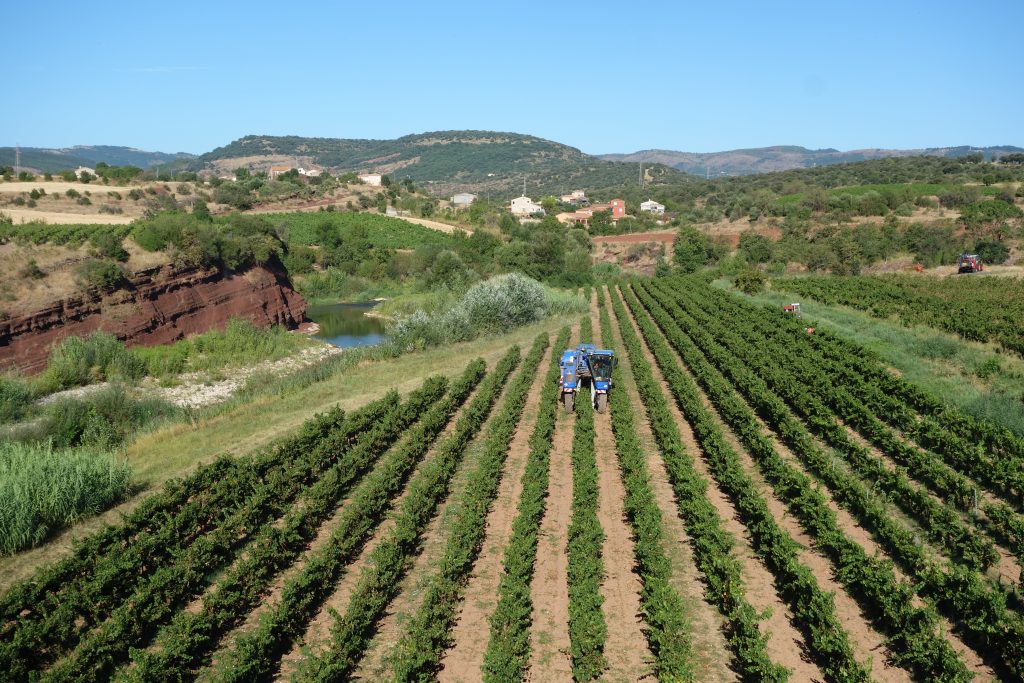
A typical scene from the south of France at this time of year, a harvester slowly going up and down his beautiful rows of grapes
Way back in 1982 Julie and I were living in London and running short of cash. There were two get-rich-quick schemes running at the time for young backpackers – you either go to Iceland to pack fish or you go to the south of France and pick grapes. Kind of a no-brainer, we chose the grapes.
We ended up in the small village of Adissan in the wine growing district of Languedoc where we lived with a young French couple and picked grapes for 17 continuous days. It was backbreaking horrible work and our pay, which included two litres of wine per person per day, barely covered our expenses to get back to London. During all the hard work and sore muscles we had a bit of fun, learned something about the wine industry and learned a lot about our limitations.

We couldn’t find our exact home in Adissan but it was possibly something like this door into a building like this
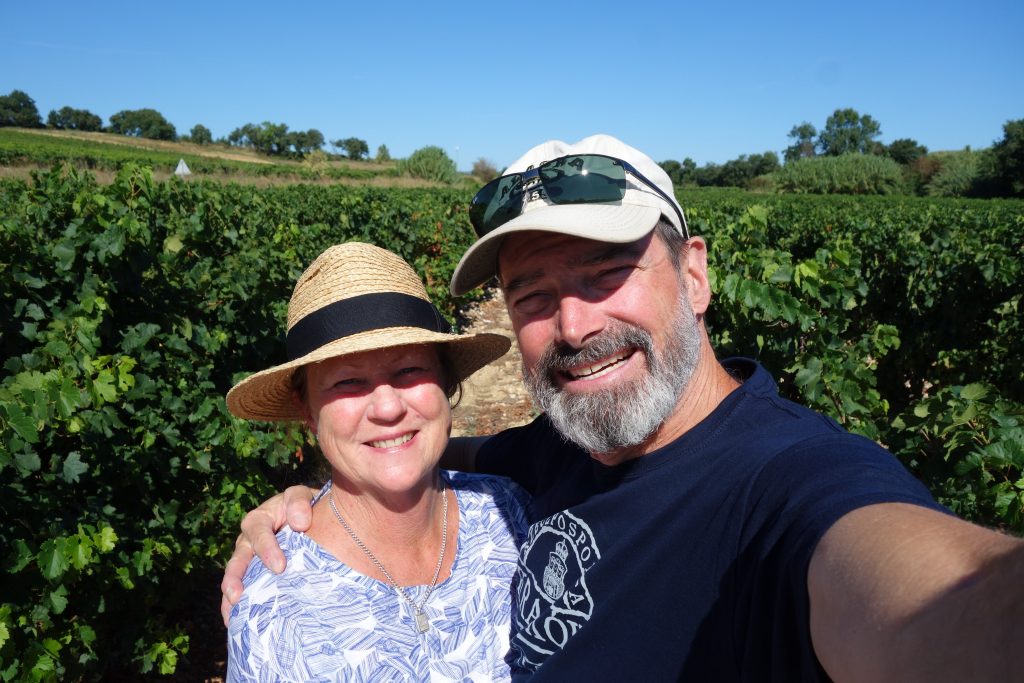
We can smile about it now…standing with our old friends sharing bitter sweet (and sweat) memories of our time picking grapes
It was because of all this we had to take a slight detour on our trip to Spain and revisit Adissan, partly to relive those memories and partly out of curiosity. Unfortunately our memories of the village were quite vague and despite the quaint narrow old streets and obvious landmarks in the town we couldn’t find the building where we lived. Never mind, we found the old wine coop where our picked grapes would end up and bought some local wine from the modern winery at the coop.
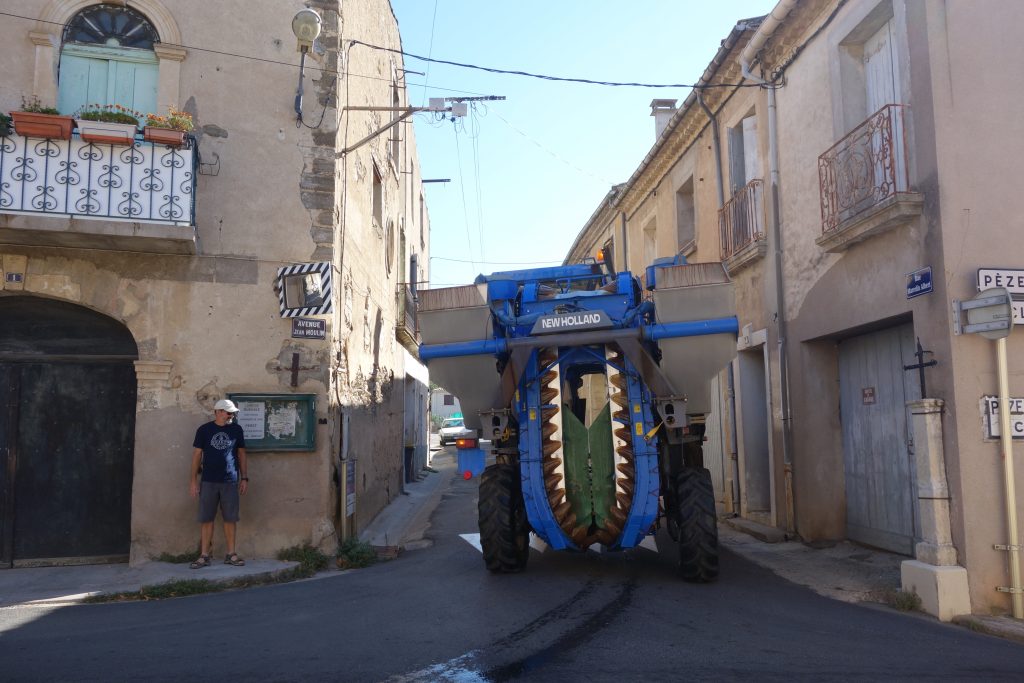
They didn’t have this in our time…a large grape harvester drives through the narrow streets of Adissan
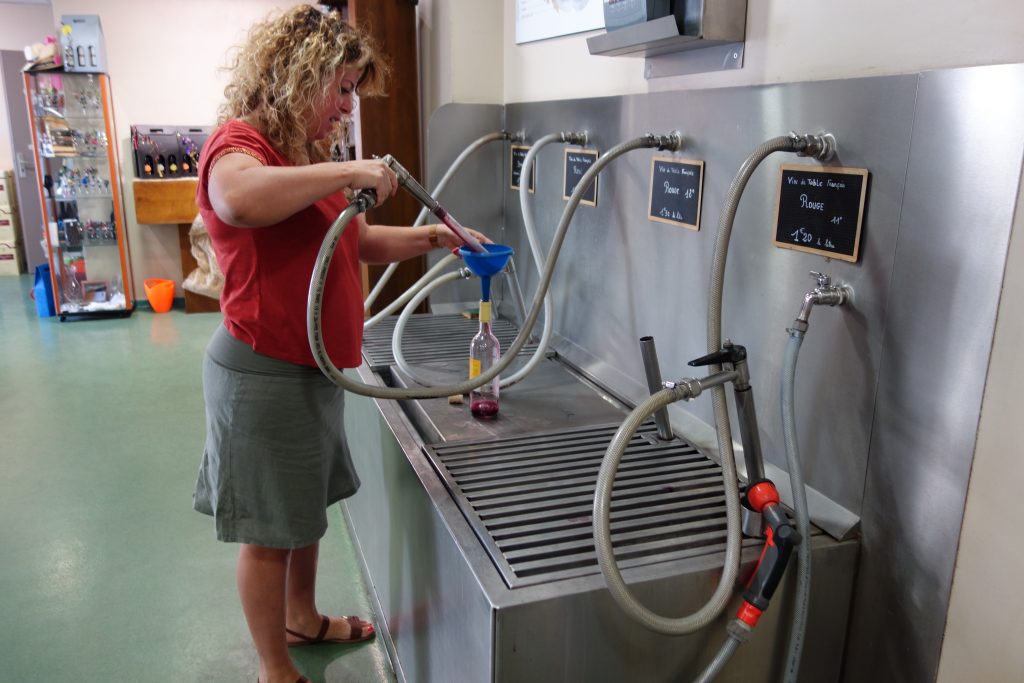
When in Adissan you buy wine from the local wine coop. In addition to a couple of branded bottles we also bought a bottle of coop wine which the friendly lady sprayed into a spare bottle she lent us. Cost = 1 euro.
Adissan was a fun stop for the nostalgia but our main target before crossing into Spain was the medieval walled town of Carcassonne. Carcassonne is the largest fully walled city in Europe and is a fabulous representation of what a medieval town must have looked like back in the day. The narrow winding cobblestone streets, beautiful basilica, imposing chateau and high protective walls are now filled with tourists who soak up the wonderful – if not crowded – town streets, shops and restaurants.
We had a fun afternoon doing exactly what everyone else was doing, including having lunch in an outdoor café and enjoying the local specialty, a cassoulet. The traditional cassoulet is a bowl of pork and beans baked to a solid yummy mass and served hot. Carcassonne scores top points.
But we had another mission that afternoon. Without too many gory details, a long term benign cyst on my back had flared up big time and became quite infected. Reluctantly we went to the hospital, hoping for a quick slash, clean and patch job but instead the doctor grimaced and announced he would have to operate under general anaesthesia and I would be spending the night at their fine establishment.
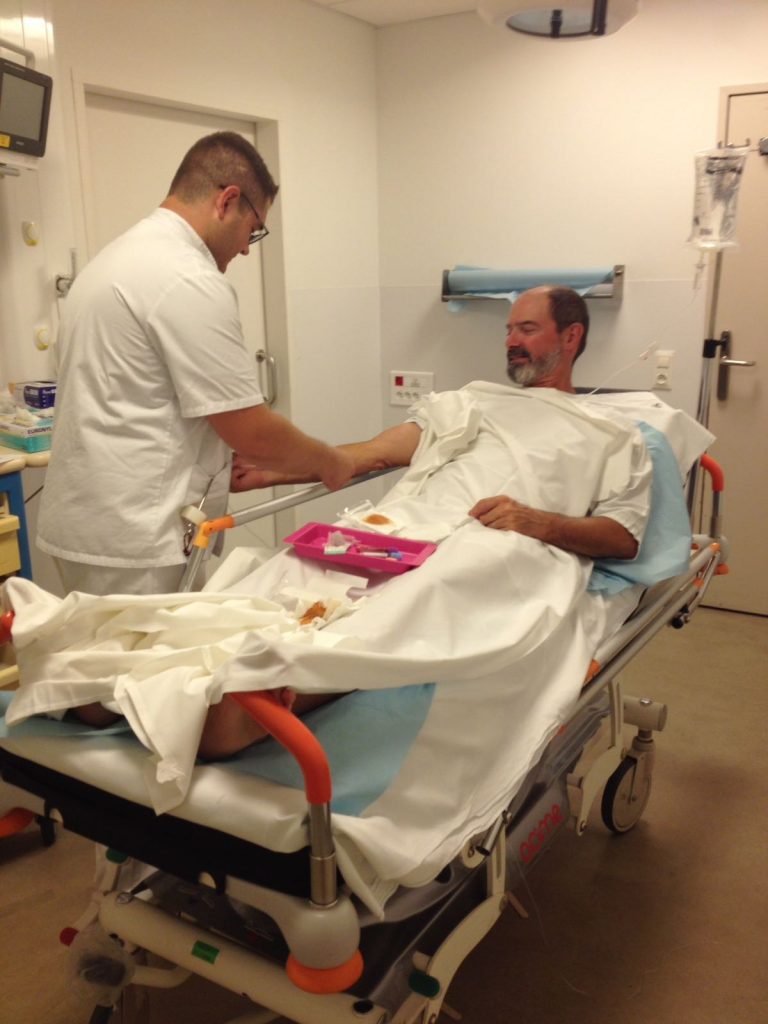
There I was, just walking down the street minding my own business and suddenly I’m getting prepped for surgery at the local hospital
OMG, that wasn’t the expectation at all. We were taken aback, trying to process the implications and logistics of this sudden turn of events. Never mind, at 8pm I went under the knife while Julie went back out to Tramp – which luckily was parked in a good spot in the hospital carpark – and spent the night there alone while I recovered in room B2119.
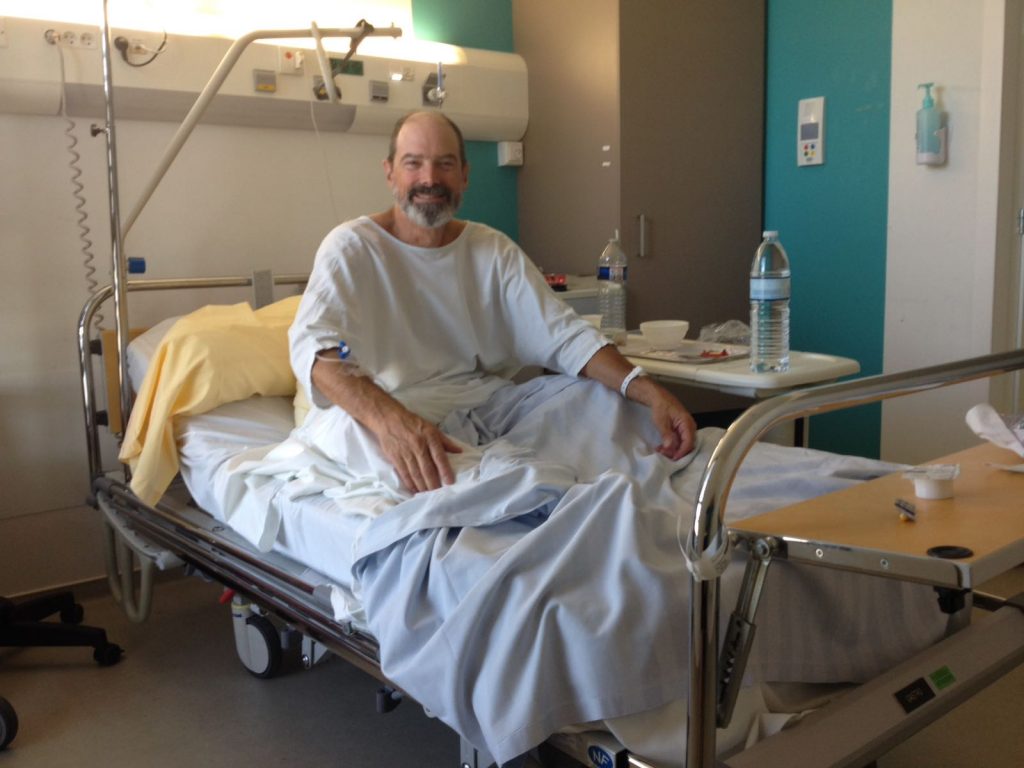
I survived! With a hole in my back and a bigger hole in my bank account they eventually let me leave the hospital.
We reunited the next morning and with a big patch covering the hole in my back we finally left Carcassonne Hospital by mid-afternoon. Sheesh, what an experience! We certainly didn’t see that coming.
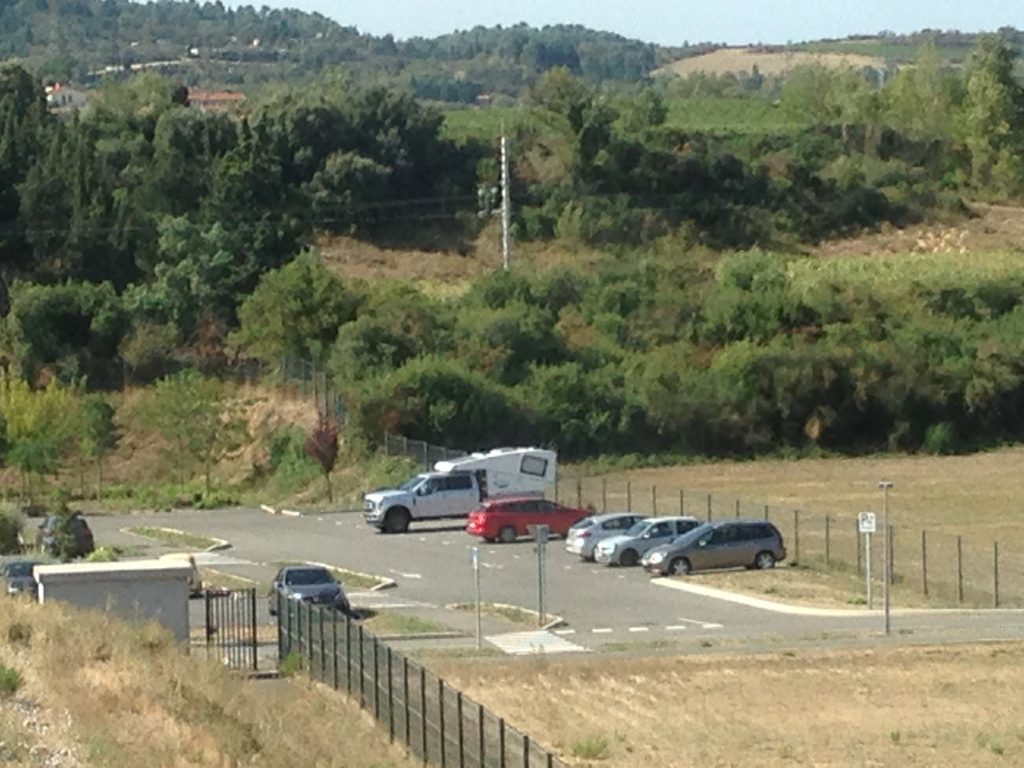
This is the view from my hospital window – Julie and Tramp camped in the hospital carpark without me
Wounded but not deterred, we camped that night in the foothills of the French Pyrenees Mountains, cow bells aplenty, near a small village at 1,300 metres. The next day we followed the winding road, above the tree line, through the dramatic switchbacks until we hit the border of the small principality of Andorra. Andorra is an anachronism of European geopolitics, high in the mountains, stuck between France and Spain, like a friendly cyst on the back of Europe.
In days of old Andorra was a tax free duty free paradise but with the intervention of the European Union this concept has faded. But Andorra still features stunning mountains, world class skiing and uber-cheap booze and cigarettes. We stopped at the first town, El Pas de la Casa, squeezed between ski chairlifts heading off in all upward directions and a steep spectacular switchback road. We stocked up our barren bar while we watched French families fill up their car’s boots and roof racks with huge piles of cheap stuff. Wow!
The drive down towards Spain was equally rewarding, through a series of well-developed ski villages until we hit the capital of Andorra la Vella. This crowded and chaotic mecca for cheap shopping and skiing drowns out the great mountains that rise above it and we found the signs for Spain as soon as possible.
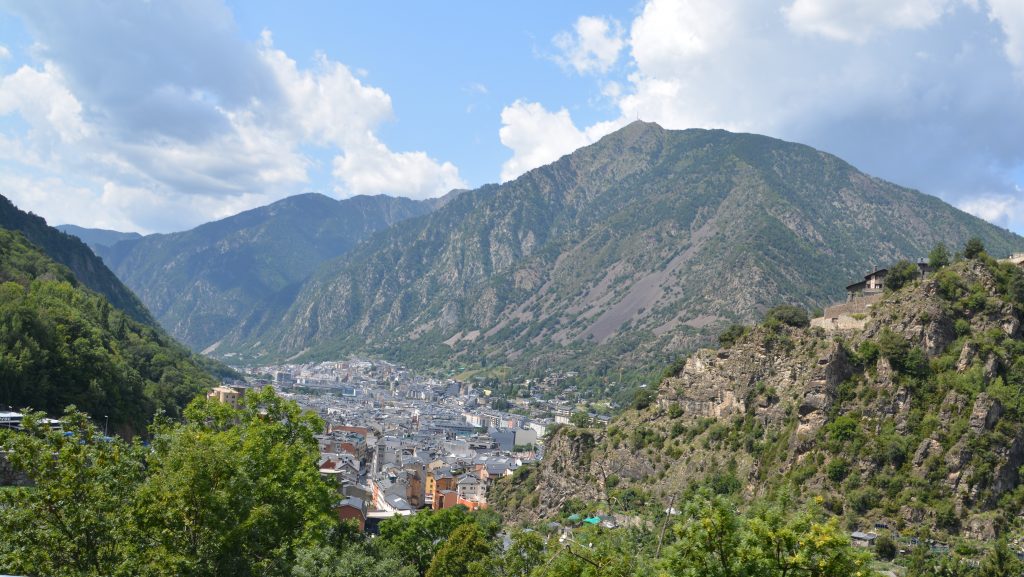
The capital of Andorra la Vella was surrounded by beautiful mountains but the town was too crowded and chaotic for Tramp
Ah, Spain. As soon as we crossed the line we felt good. Spain is a relaxed and friendly place for visitors, their language is familiar to us, their culture and lifestyle appealing. But this is not just Spain. The north-eastern corner of Spain is covered by the autonomous region of Catalonia which has its own flag, language and culture. Catalonia has longed to be independent of Spain and regardless of where you sit on this issue you can’t help but see signs of their proud heritage.
We followed the scenic road out of the mountains and headed towards the Mediterranean coast and the vibrant city of Barcelona. One of the gems of Europe, Barcelona needs to be on everyone’s grand tour of Europe, and so it was for us. We camped that night near the beach south of the city in one of those over-crowded over-priced metropolises of European travel. Never mind, we were in Spain and all was good.
Barcelona, Spain’s second city and Catalonia’s economic heartbeat, is a city above most others. Rich in history, oozing with art and culture, magnificent tree lined boulevards, a fabulous old quarter, a dynamic port and marina and some of the true icons of European travel.
It would be easy to say that the Champs Elysees in Paris is Europe’s most famous street and perhaps London’s Oxford Street would get some votes also. But there can be no doubt that La Rambla in the heart of Barcelona is in that class, its wide promenade separating the traffic along beautiful old buildings, cafes, souvenir vendors, flower shops and street performers all vying the space with the constant crowd that moves up and down La Rambla.
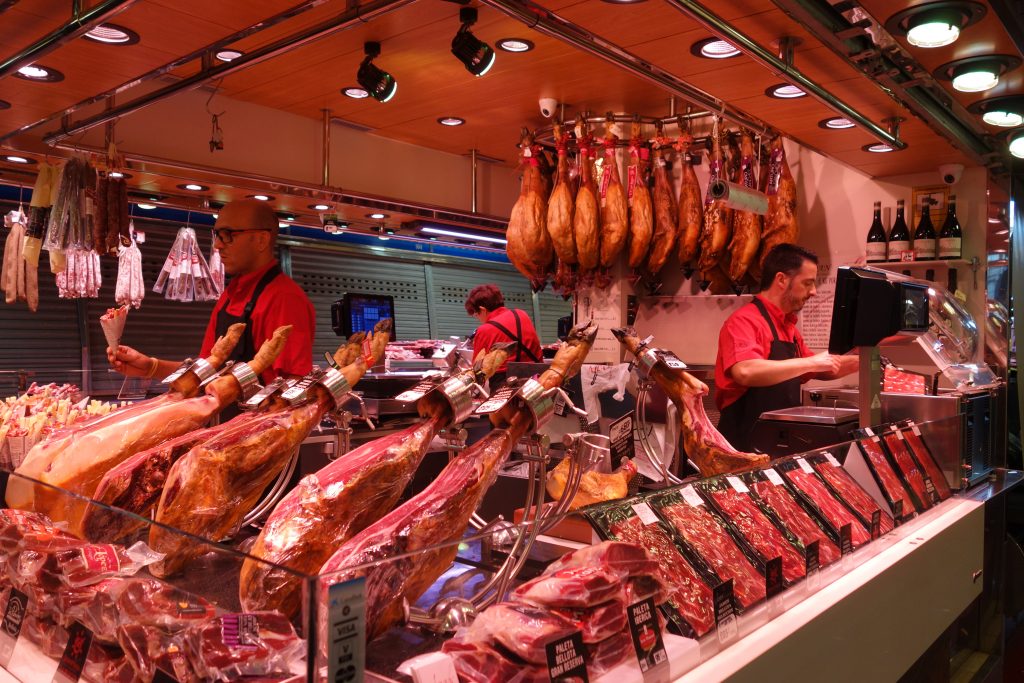
We visited the old market just off the Rambla and found plenty of beautiful hams available for sale – a Spanish specialty
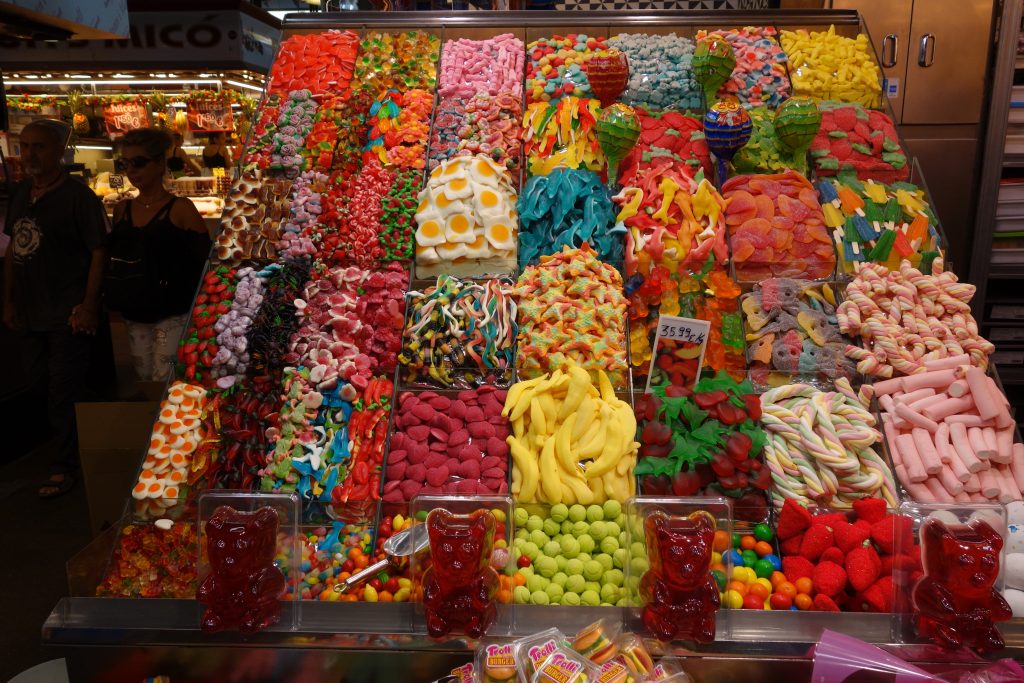
I’m not sure if all these sweets and lollies are a Spanish specialty but they were very colourfully and spectacularly on display for sale
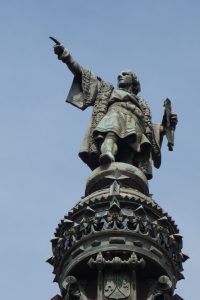
Christopher Columbus, standing on his pedestal pointing out to the new world which he ‘discovered’ in 1492
There are probably two men that stand out as making Barcelona famous. The first is Christopher Columbus who sailed the ocean blue in 1492 from Barcelona under the patronage of King Ferdinand and Queen Isabella and whose impressive column and statue marks the end of the Rambla at the seaside port.
The other prominent man of Barcelona history is Antoni Gaudi, an architect and builder who contributed his unique and some would say bizarre design features on his numerous buildings, parks, lamp posts and many other features over 100 years ago. To say Gaudi is an institution in Barcelona today is an understatement – there are Gaudi souvenir shops, Gaudi tours, Gaudi restaurants, Gaudi mobile phone shops and Gaudi tire repair shops. Park Guell was designed by Gaudi as a residential and open park area – today it draws a staggering four million tourists a year to see the strange buildings and structures he built there.
But the crown jewel of Barcelona, and indeed one of the great attractions in all of Europe, is La Sagrada Familia, the basilica designed by Gaudi and whose construction has been going on for about 140 years. Gaudi spent the last 43 years of his life dedicated to this spectacular place of worship with a design and features not seen or imaged anywhere else in the world. It is optimistically estimated the church will be completed in 2026, the 100th year anniversary of his death, but in the meantime is has to be the most awe-inspiring and spectacular construction site in the world.
We packed a lot into a full day in Barcelona, catching the public bus from our campsite and spent the morning slowly walking down and absorbing the full-flavour atmosphere of La Rambla and wandering through the narrow streets of the old town, called Barri Gotic, including the spectacular gothic cathedral and the stately and shady Plaza Reial.
That afternoon we walked through Park Guell to goggle at all of Gaudi’s catching and unusual architecture before arriving at La Sagrada Familia. The basilica, which has only eight of its intended 18 towers completed, is designed like no other, full of religious symbolism but sprinkled with oddities like towered topped with large bunches of colourful fruit.
Walking into the basilica takes your breath away. Bigger than expected, pillars designed like spreading trees to help hold the immense roof, stained glass windows of dazzling colours, no chapels or vaults to distract from the overall size. We used the audio guide to get the full picture but all the scenes, both internally and externally, are amazing without the words.
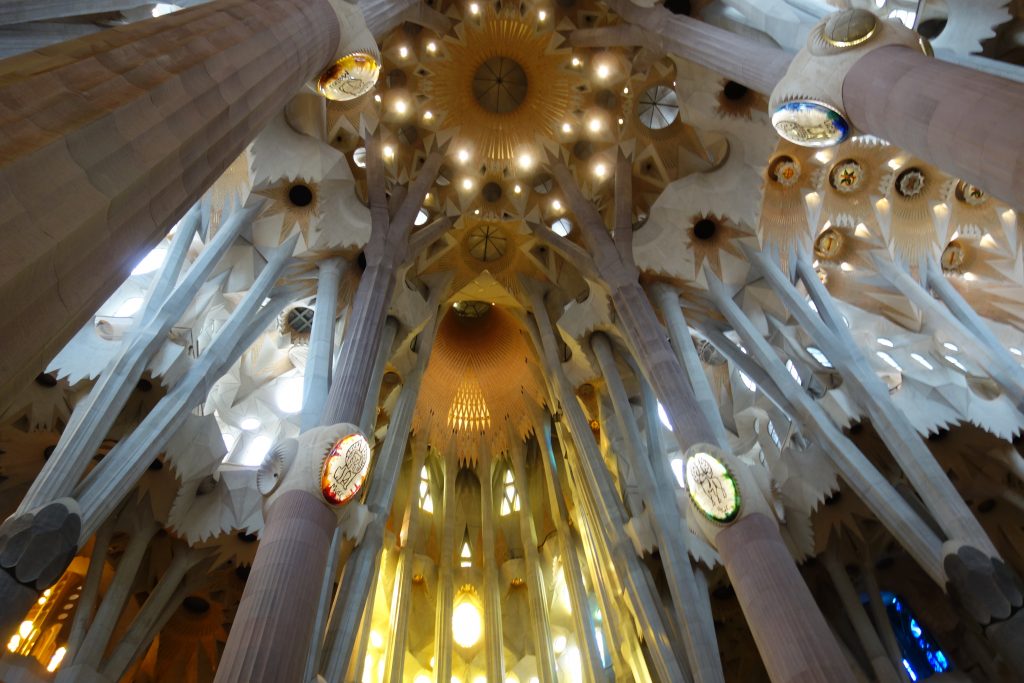
First look at the inside of this church, like no other in size, design and scope, the interior left us breathless
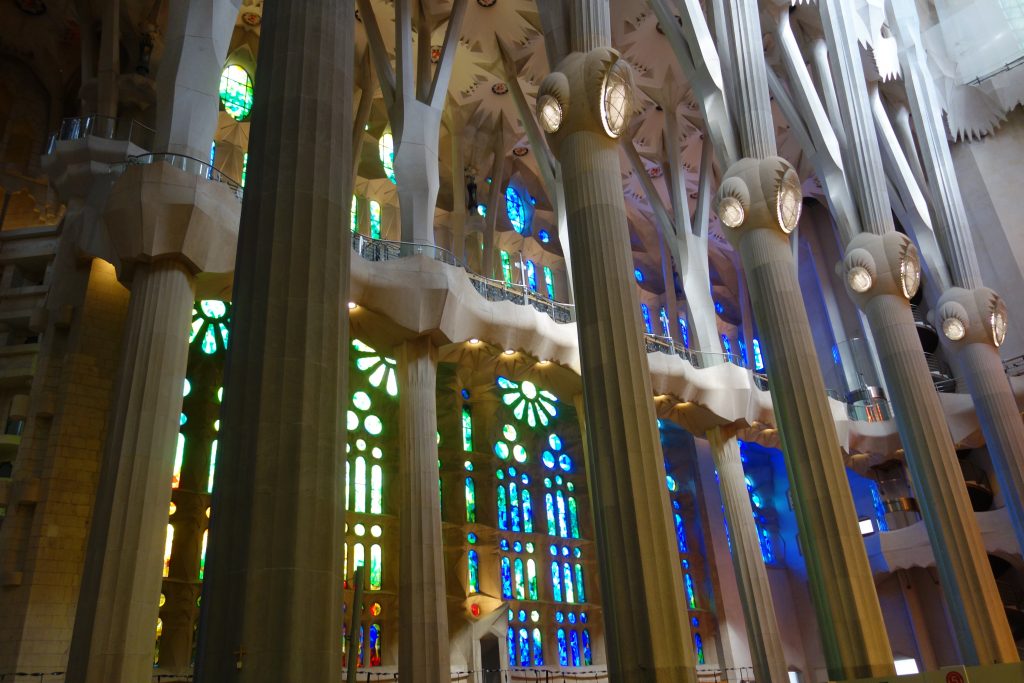
Photos and words can’t fully describe what an unusual and attractive church this was – you just have to see it yourself
We finished our day at a Cerveceria on Plaza Reial enjoying a couple of cold beers and watching the Catalonian world go by. It had been a fabulous day but our thoughts turned to what’s next. From Barcelona we were planning to head south along the Mediterranean coast to parts unknown and take in more of Iberia.

Phew! After all that beauty and culture and fun we definitely deserved a beer or two on the Plaza Reial
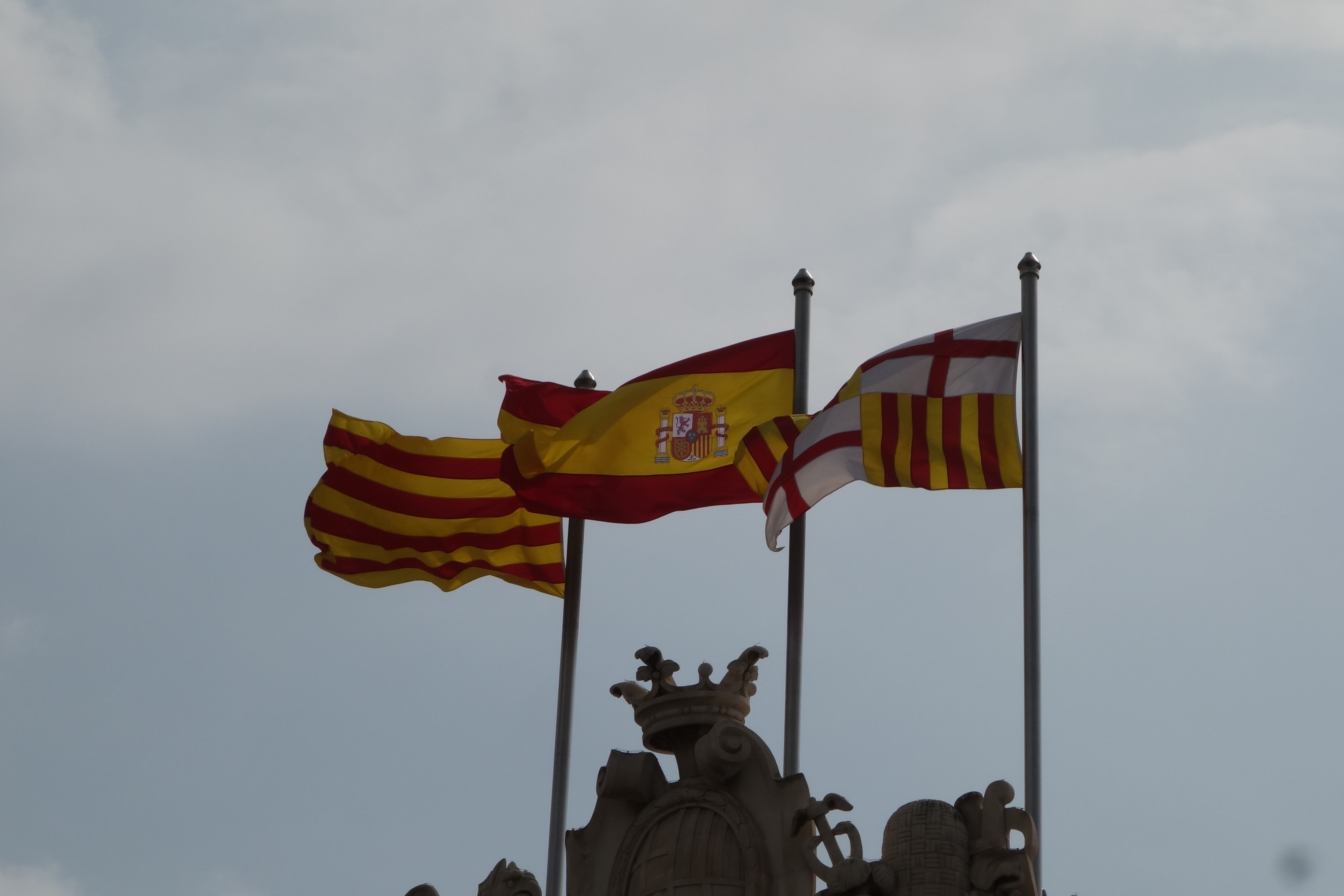






















Loving the photos. You two look so well, after your scare ( and scar ). We hope the follow up results are good, and the doctor’s got all that they should have. Will be lovely to catch up in December. Take care of each other. Lots of love and hugs,
Anne xoxo
Hi Anne. Yes, I’ve been under the good care of my travelling nurse and it appears I’ve healed well so no problem. Catch up soon! Bill